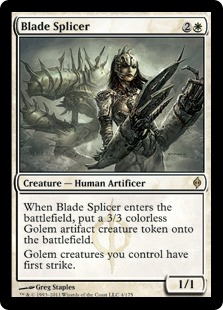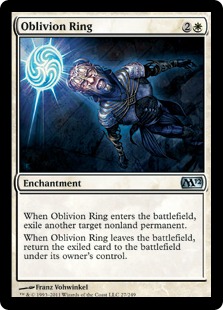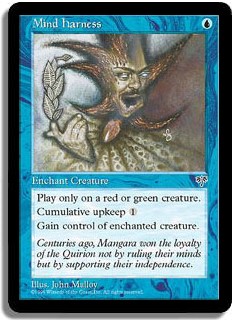I wanted to play Stoneblade. I really, really did. But all signs pointed to RUG Delver being the better deck, and my resolve wasn’t strong enough. I’d never played it before; what harm was there in trying it once? "You’ll like it," my friends told me. "You should just play it. It’s really awesome and you know how much you liked playing Delver in Standard." And a part of me did want to try it, to just throw caution to the wind and pick up the deck I’d once been so confident I could beat.
That’s the problem with Delver, though. It’s secretly a gateway card. You start playing with it once, and you get sucked in. It starts off real friendly like: a cute, narrow card finding its niche in that adorable Illusions deck. Then it’s picking up Invisible Stalkers, stealthily gaining more and more percentage as decks are less able to keep up with the fast and furious lifestyle it represents. But you’re not worried because you’re still in control. You can play anything you want, right?
Then you hear whispers about an even better Delver deck in Legacy with 28 instants and sorceries, 19 lands, Brainstorms, Force of Wills, and Tarmogoyfs. But you still have your resolve, you’re above the influence, and you play honest, interactive Magic with reliable Snapcaster Mages, Swords to Plowshares, and Jace, the Mind Sculptors. But everywhere you see this new, more powerful Delver deck getting more popular, and you start second-guessing yourself. What if it really is the best thing you can be doing in Legacy? Then, one fateful day, not even the supercharged Standard Delver with Restoration Angel can satiate you.
You just borrow the cards the first time, because you’re certainly not going to be playing it long; just long enough to see what it’s like. And you head to the tournament, where your friend asks you to register decks for both of you. You write up the 75 twice, down to the last Submerge.
Then you break.
You know what? It feels great. "Why did I not try this before?" you think to yourself. But you’re stuck now, and you’ll be playing Delver for the rest of your days. There’s no escape from the deadly circle of Delver outside of a mandatory DCI-sponsored intervention.
Delver. Not even once.
As you can probably tell, it seems that our little Insectile friend has Standard in a vise grip, and despite my love for former villains Stoneforge Mystic and Jace, the Mind Sculptor, I was not immune to playing as the new, improved dark side in both formats. I had moderate success, but unfortunately I ran afoul of two semi-mirrors towards the back end of Day 1 and went from an auspicious 6-0 start to a mediocre 7-2-1 Top 32 finish. Not to discount the deck, as Matt Costa and I played Blade Splicer over Geist of Saint Traft to enable a smooth transition to Sam Black U/W Midrange deck in postboard games.
I think that was the right call, and I was quite pleased with our list. We’d managed to solidify a reasonable Naya and Zombies matchup by replacing a bad three-mana creature with an excellent one for wresting the initiative from an aggressive opponent. Don’t get me wrong; Geist of Saint Traft is incredibly good, especially with cards like Vapor Snag to clear the path for this guy to get busy. It’s just that curving Blade Splicer into Restoration Angel is nigh impossible for an aggressive deck to beat. Those aggressive decks are what you want to ensure you beat, and this plan also allows you to position yourself as the control deck in a mirror match that frequently gets very grindy.
Blade Splicer over Geist enabled us to play only slightly less aggressively than we otherwise would have been able to, while making our Restoration Angels much, much better and making it nearly impossible to beat us with cards like Strangleroot Geist. Let’s take an example matchup, one that I played twice over the weekend: Naya Pod. While they are playing Blade Splicer and Restoration Angel for their amazing synergy as well, they have no way to break up your Angel/Splicer combo while you have Gut Shot, Dismember, and Vapor Snag to steal tempo from them when they try it or to keep their Angels from doing anything useful.
Basically, you are both playing the same type of value interactions in your decks, but their enters the battlefield triggers are Splicer, Huntmaster and maybe Acidic Slime, while yours are Snapcaster Mage and Blade Splicer (the best enters the battlefield triggers short of a Titan) and you play a virtual 6 of each of those due to Ponder and Probe. Then you get to sideboard into Day of Judgment, which they have to walk into because if they don’t overextend, you’ll Vapor Snag them out of the game. On top of that, you get Phantasmal Image to double up on your best triggers and copy theirs as well as to keep random Strangleroot Geists from bashing you too quickly. How can they realistically hope to beat you?
Here’s the list I played, and I heartily recommend taking a look at the top finishing decks from the tournament if you want a good chuckle looking at all those Delver addicts.
Creatures (18)
Lands (22)
Spells (20)

I really liked the maindeck, and although I’d like to play Sword of War and Peace, I’m not sure that you want to be doing that when there is such an opportunity to be blown out by getting your Sworded guy Vapor Snagged or Dismembered. That’s the only drawback of playing this build in the mirror match, and in exchange, your Angels are better in the grind and you get to answer their Geists with Image, whereas they have few good answers to Splicer/Angel.
I’d strongly consider playing a second Thought Scour over the fourth Gitaxian Probe, as end stepping a Snapcaster to Thought Scour yourself is pretty awesome when both players are jockeying for openings to resolve big spells. But the information from Gitaxian Probe is also so crucial in the mirror match! I’m leaning towards the second Scour right now, for what it’s worth.
As for the Sun Titan / Consecrated Sphinx split in the sideboard, well, I honestly don’t know what you’d rather be doing. The problem is that most players are on to Plummet and Crushing Vines, and you need to keep your supposed trump from being answered so easily. The problem with Sun Titan is that it’s actually not always a trump. I’ve seen it just be a 6/6 with vigilance in this deck, and unless you’ve already traded off Blade Splicers and Phantasmal Images, it can easily be less impactful than you need it to be for six mana.
Consecrated Sphinx, if it doesn’t get Plummeted, is going to block more effectively as it can actually block Restoration Angel, Delver of Secrets, and an Angel token, and it will always pull you far ahead regardless of what’s hit the graveyard so far. Choosing this pair of sideboard slots is one of the closer decisions I’ve had to make regarding Delver recently, and I wouldn’t be surprised to see myself run the 1-1 split again simply for lack of knowing what’s really better.
One additional reservation I have is with Oblivion Ring as a two-of in the sideboard. I don’t like having so many three-mana cards postboard, as Blade Splicer, O-Ring, and Timely Reinforcements all crowd out that spot defensively. It is still the best and most flexible answer to Sword of War and Peace, Gideon Jura, Sun Titan, and Consecrated Sphinx in the mirror and is still applicable against decks like Zombies and Naya Pod, so I may have to end up keeping the pair despite the awkwardness of a sorcery speed three-mana answer.
The beauty of going between Delver and Midrange is that you gain an additional element of mystery when you sideboard and a whole new level of customizability with regard to determining who the beatdown is. Your opponent isn’t going to know where to place you on the sliding scale between tempo-based aggro and a very capable control deck. After all, Gideon Jura and Delver of Secrets are fairly different plans and require different answers to properly combat.
The worst part for them is that because of your card selection, you can change where on that scale you’re located in the middle of the game. Even though Gideon Jura and Sun Titan may be in your 60 in game 2, you can Ponder for the appropriate part of your deck to let you put down four power on turn 3 and six power on turn 4’s end step, and then just mash their face in.
The downside of being right in between these two strategies is the loss of Swords, which allow for some pretty sick swings in concert with Restoration Angel. I personally believe that the gain in Blade Splicer synergy and in the ability to play defensively with the three-drop is worth this loss, but I understand that some people just want to be able to swing the game strongly in their favor on turn 5. The decision to play Swords allows them to set up a different kind of blowout than my Gideons allow me.
So now that we’ve beaten Delver to death and cracked a couple of jokes at its expense, it’s time to move to Griselbrand’s format, where I played…oh wait.
Creatures (13)
Lands (19)
Spells (28)
Sideboard

To be fair, Griselbrand is so damn powerful that he can even squash that pesky Insect, and there are various ways to cheat him into play. Reid Duke and Darwin Kastle made the Top 8 of the Legacy Open playing two very different decks that both abuse Griselbrand.
Creatures (8)
Lands (19)
Spells (33)

Creatures (8)
Lands (18)
Spells (34)

These three decks seem to me to be the ones that merit serious consideration for the SCG Open Series featuring the Invitational in Indianapolis and future Legacy tournaments, and their existence does push a lot of the format out. I’d have to say that despite Maverick doing its best to survive as a fair deck in an unfair format, Griselbrand is going to make life very, very challenging for the green deck going forward. Karakas and Thalia, Guardian of Thraben are great, but they aren’t going to stop Griselbrand from entering the battlefield on turn 3 and effectively ending the game. After all, Karakas can’t stop a Sneak Attack with several red mana available from putting in Emrakul over and over again.
So what’s the difference between Reid’s deck and Darwin’s? And which one should you play, assuming you have access to all the cards for both decks? Well, Reid’s decision to play his deck was based on the fact that it is favored against Sneak and Show, with Show and Tell uncastable versus another Griselbrand deck, and Thoughtseize allows Reanimator to pick its game plan with perfect information. Additionally, Reanimator’s key spells all cost one and two mana, which are better at beating Daze and Spell Pierce than Sneak and Show’s namesake spells.
The drawback? You have to battle through Tormod’s Crypts, Scavenging Oozes, Surgical Extractions, and the like in games 2 and 3. That’s no fun since anyone can play those cards against you, unlike Sneak and Show, where only a small percentage of blue and black cards in Legacy interact with you in any meaningful way (and Karakas, sort of). Comfort matters a huge amount in this format, and if you’re comfortable with Sneak and Show you should almost certainly stick with it.
It takes a decent amount of practice with Reanimator to recognize when you can and can’t play around certain spells, and the fact that you’re frequently taking eight for your Griselbrand off the bat makes matches against aggro closer than they would be with Sneak and Show. However, if you used to play Reanimator and you want to see if you can recreate Reid’s magic this weekend in Indy, you should certainly give it a shot; the deck is very, very powerful. It even has a fine matchup against RUG Delver!
My decision to even go to Worcester was made in part because I wanted to get practice with the decks I planned on playing at the SCG Invitational and in part because I thought it would be fun to hang with my Boston friends over the weekend. Big shout-out to Ben Winterhalter for letting Matt and me crash at his place over the weekend and for playing the Stoneblade deck I wasn’t man enough to play!
Unfortunately, the weekend was very disappointing and draining for me. I went to BWI Friday evening for a 9:30 PM flight out to Boston, where I got picked up by Matt in his adorably vintage Toyota Camry. When he turned on the car, I was rattled by a loud buzzing sound coming from the backseat. Turns out, since the antenna on the car doesn’t work, every time the car is turned on it tries in vain to extend the antenna and that unpleasant sound is the result. At least it served as a good way to wake us up for the two early morning drives out to Worcester, which is unfortunately a good hour outside Boston proper.
We didn’t get to sleep or eat much over the weekend, since we got to bed around 2 AM Friday night and had to wake up at 7:45 AM and didn’t finish Saturday until midnight. Then, because Matt was thoughtless enough to make Top 4 (the nerve!), we had to get up at 6:30 AM to get to the site for his semifinals match. On top of that, since he played until midnight in the Legacy Open, we didn’t get back to Ben’s place until 1 AM again, and I had a 6:30 AM flight back to Baltimore for work at 9:30 AM. I can’t pinpoint a spot where lack of sleep hurt me too blatantly, but I definitely plan on getting to bed at a reasonable hour for the SCG Invitational.
Also, none of the restaurants near the convention center were open when we checked at 10 PM Saturday night and 8 PM Sunday night. What are you doing, Worcester? That was almost more disappointing than getting ninth on breakers at the Legacy Open, but as Dustin Taylor said, missing on breakers just shows that I’m mortal and can’t run exceptionally well all the time. Considering the amazing hot streak I’ve been on since getting the free invite to Barcelona, I figure this is at least fair.
As for our Legacy deck, I like the maindeck a good amount, I believe that playing Stifle is wrong, and I think that our full complement of Daze and Force of Will is the better plan. I also liked the one maindeck Scavenging Ooze, as it’s particularly powerful against any green deck and incidentally gives you interaction with Reanimator and Dredge. I’d consider playing a second one in the sideboard over the fourth Submerge, since six cards just for other green decks seems like overkill when Ooze comes in for more matchups, including the newly resurgent Reanimator.
Also, Mind Harness: what a card! It’s just perfect for this type of deck that is frequently tight on mana but needs cheap, swingy cards to gain huge amounts of tempo against Knight of the Reliquary decks. I probably wouldn’t run a third copy, but it was pretty sweet as a two-of. The idea with this kind of deck is that you maximize every last card and land drop and always squeeze out the win by the slimmest of margins. I’ve had one land in play, no cards in hand, and two creatures attacking for exactly lethal at least a couple of times, and that kind of game is what makes Magic interesting and exciting.
One important tactic I missed in round 4 of the Legacy Open was Thought Scour versus the Miracle deck. I aggressively Scoured myself, digging because I wanted to see if I could find more action, but I didn’t need to do that. My opponent, predictably, Brainstormed at the end of my turn and untapped with two Terminus on top of his deck. Of course I should have seen that one coming, as it’s basically the entire purpose of the deck. So treat your Thought Scours with respect! They are often the best card in your whole deck in certain matchups.
As for general sideboarding, it should be obvious that Forked Bolt is bad when your opponent isn’t a green deck, and Red Blast comes in when it has targets. Cut Force of Will when they are a fair deck, and bring in Life from the Loam when it seems useful (the mirror especially).
Whatever you do decide to play at the StarCityGames.com Open Series featuring the Invitational in Indianapolis, good luck, and keep trying to improve with every match!
Best wishes,
Ben Friedman





